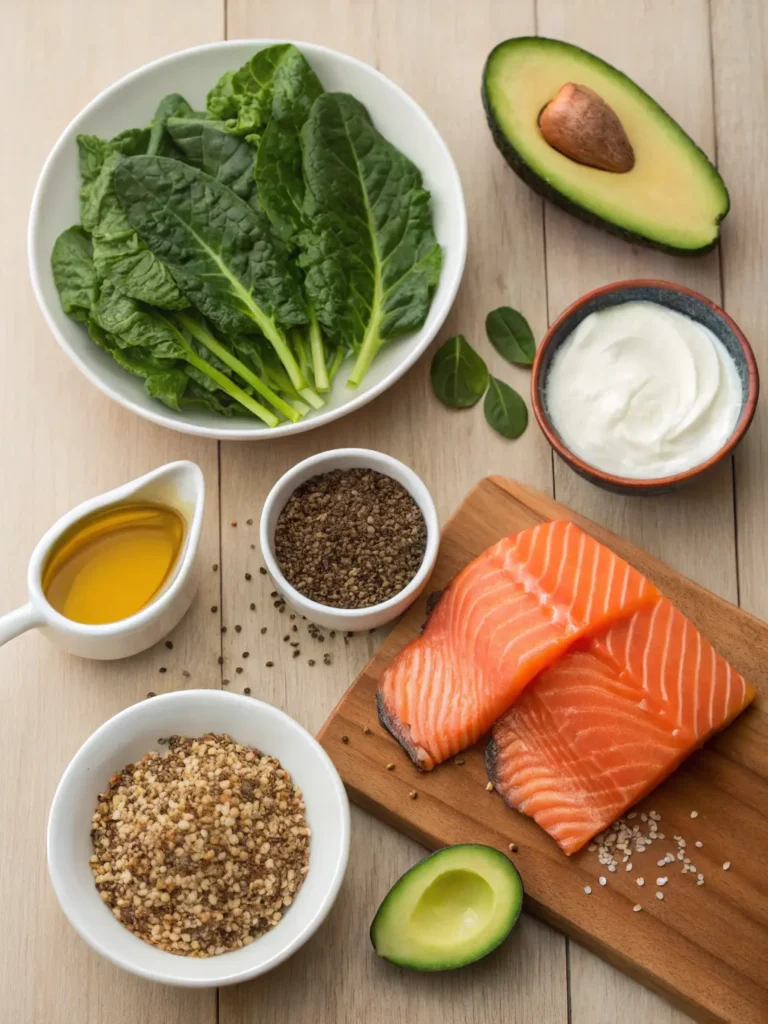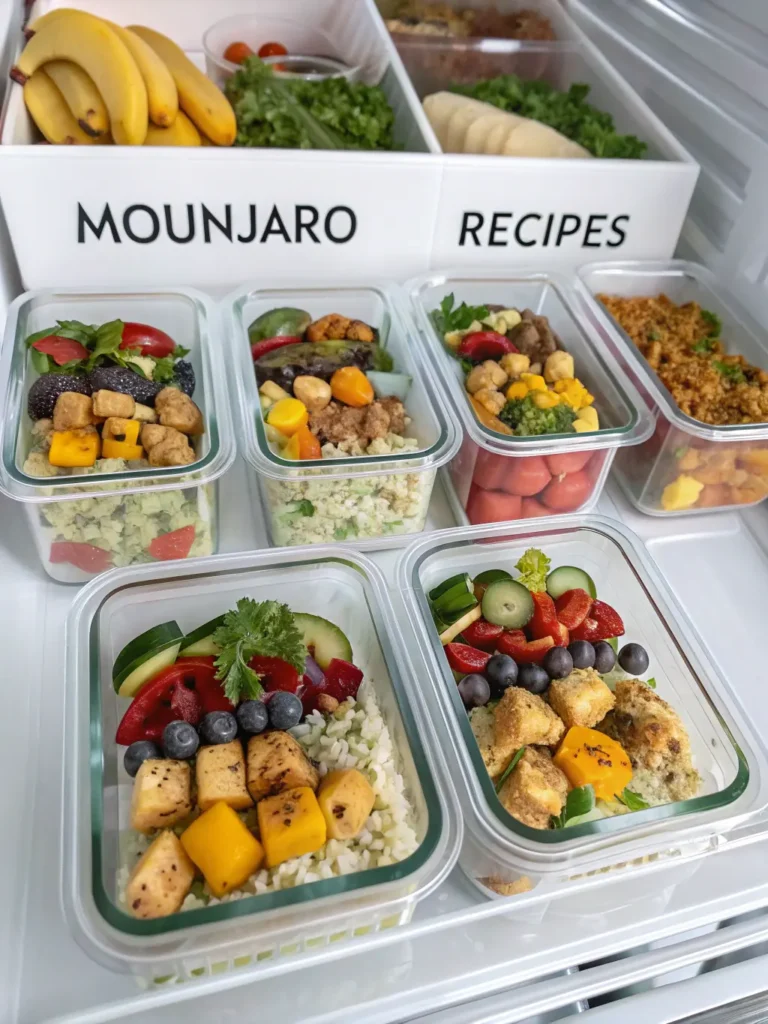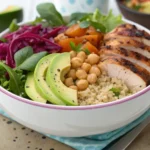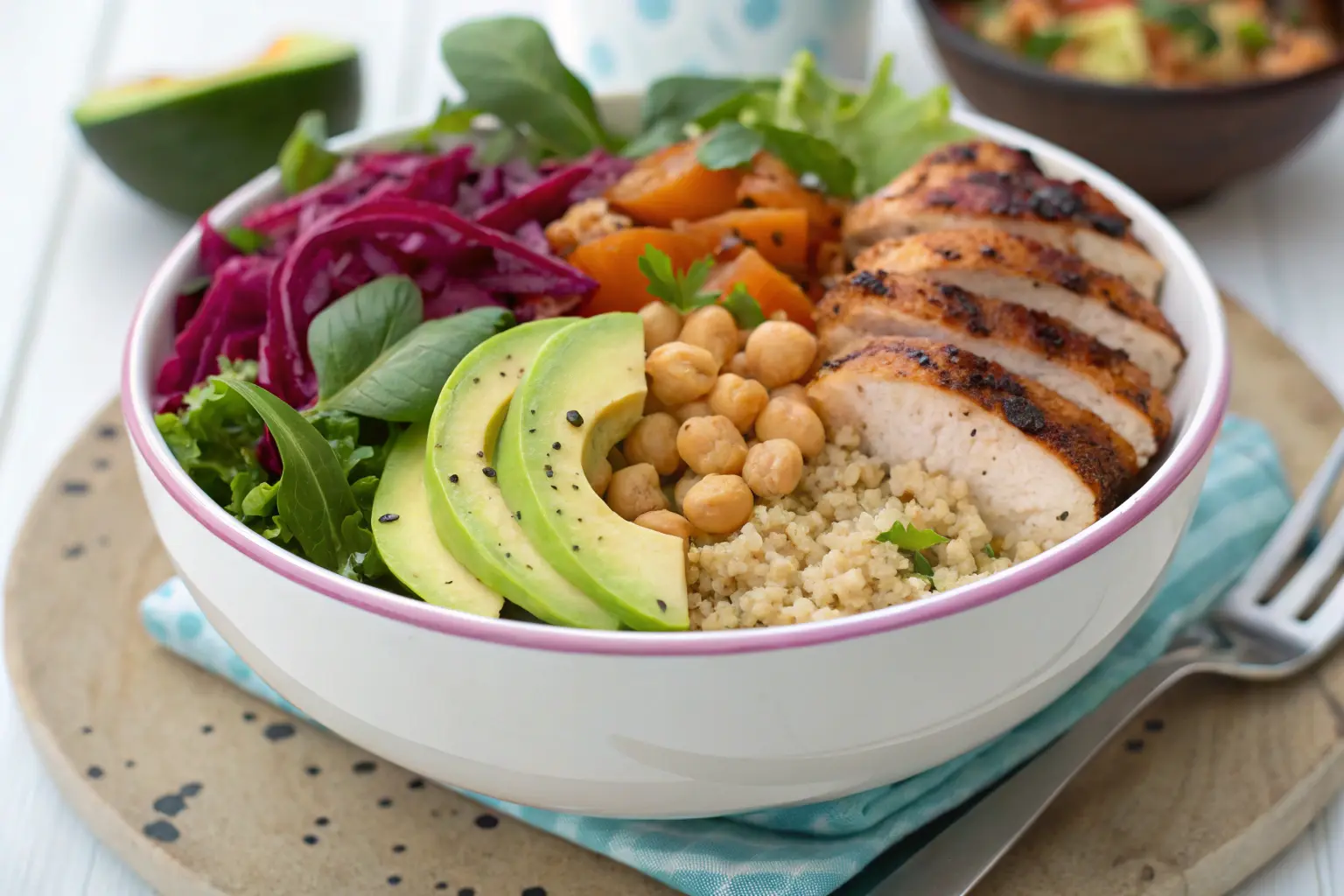What Is a Natural Mounjaro Recipe, Really? So, you’ve been hearing about Mounjaro all over the place — maybe on TikTok, maybe from your cousin who “suddenly” dropped 20 pounds — and now you’re wondering: Is there a natural way to get those same effects without the injections, prescriptions, or side effects?
Short answer? Kinda.
Now, let’s be clear: this post isn’t about trying to replace your doctor, and it definitely isn’t anti-medicine. What we are doing is breaking down the science in a way that makes sense — and showing you how to build a natural Mounjaro-style recipe that supports:
- Balanced blood sugar
- Long-lasting energy
- Appetite control
- And sustainable weight loss (without starving)
And the best part? It’s all done with real food — ingredients you probably already have in your kitchen. No magic powders or weird supplements required.
If you’re someone who wants to feel fuller longer, reduce cravings, and support a healthy gut without going full pharma? This post is your jam.
Understanding Mounjaro and Natural Mounjaro Recipe Alternatives
Before we jump into the recipe itself, let’s break down what Mounjaro actually does. Because once you get why it works, it’s way easier to build meals that support your body the same way.
What Mounjaro Does in the Body (Simplified)
Okay, here’s the super chill version of the science:
Mounjaro (the name-brand version of tirzepatide) works by activating GLP-1 and GIP receptors — two hormones in your body that help:
- Slow down how fast your stomach empties
- Reduce appetite
- Improve blood sugar response
- And help you feel full longer after meals
That’s why people taking it often say they’re “just not hungry anymore.” But here’s the cool part: your body already makes those hormones naturally. And some foods help boost them.
So while we’re not promising miracle weight loss, you can definitely support these systems naturally through diet.
Can a Natural Mounjaro Recipe Support Appetite and Energy?
Yup — and here’s how.
Foods high in:
- Fiber slow digestion (just like Mounjaro)
- Healthy fats help you stay full
- Protein reduces ghrelin (aka the hunger hormone)
- Fermented foods support gut health, which affects your metabolism and hormone balance
The combo of these can create meals that mimic the feeling of being on a GLP-1 med — without the prescription or the side effects.
And bonus: you’re giving your body the fuel it actually knows what to do with.
Foods That Act Like Natural GLP-1 Boosters
Here’s the deal — if you want your food to work like Mounjaro, even just a little, you gotta focus on ingredients that:
- Keep you full longer
- Stabilize blood sugar
- Support gut health
- Slow digestion
This is where GLP-1 naturally comes into play. It’s a hormone that your body already makes, especially after you eat certain foods. And guess what? You don’t need a prescription to boost it — just the right combos on your plate.
Let’s break down the all-stars
High-Fiber Veggies That Slow Digestion
Fiber is a big deal when it comes to appetite and blood sugar. It slows down how fast food leaves your stomach, which keeps you fuller longer (sound familiar? That’s Mounjaro vibes right there).
Top picks:
- Broccoli
- Brussels sprouts
- Cabbage
- Cauliflower
- Kale
- Zucchini
Want to double up? Roast ‘em with olive oil and seasonings for a fiber + healthy fat combo.
And don’t forget beans and legumes — black beans, lentils, chickpeas — all fiber powerhouses and perfect in bowls or wraps.
Healthy Fats for a Balanced Mounjaro-Style Meal
Fat isn’t the enemy — it’s actually your best friend when it comes to appetite control. It helps signal satiety (aka “I’m full”) and slows digestion in a way that mimics how GLP-1 works.
Healthy fats to include:
- Avocados
- Extra virgin olive oil
- Nuts (almonds, walnuts, pistachios)
- Seeds (chia, flax, pumpkin)
- Fatty fish like salmon or sardines
Pro Tip: Add a spoon of chia seeds to your smoothie — they swell up in your stomach and help keep you full for hours.
Protein-Rich Foods That Keep You Full Longer
Protein helps regulate blood sugar and reduces cravings. And unlike carbs alone, it keeps your energy stable without the crash.
Natural protein boosters:
- Eggs (especially hard-boiled or poached)
- Chicken breast or thighs (skinless)
- Turkey
- Greek yogurt (unsweetened)
- Cottage cheese
- Plant-based options like tofu, edamame, or tempeh
This is especially important if you’re using this recipe for breakfast — protein + fiber early in the day helps you stay on track all morning.
Want more protein ideas? This leftover rotisserie chicken recipe is a solid way to reuse your protein and keep things interesting.
Gut-Friendly Fermented Foods in a Natural Mounjaro Recipe
Your gut plays a huge role in appetite, cravings, and how well your hormones (like GLP-1) function. So yeah — supporting it is a big deal.
Try adding:
- Sauerkraut (just a tablespoon does the trick)
- Kimchi
- Greek yogurt or kefir
- Miso paste
- Apple cider vinegar (small amounts — not shots )
You don’t need to overdo it — just adding a spoonful or two of something fermented a couple times a week makes a difference.
The Ultimate Natural Mounjaro Recipe to Try at Home

This recipe is built to give your body the same benefits Mounjaro targets — appetite control, stable energy, and slowed digestion — but through whole, nutrient-dense foods.
It’s loaded with:
- Fiber-rich vegetables
- Lean protein
- Healthy fats
- Gut-supportive extras
Let’s get into it.
Whole Ingredients That Make Up a Natural Mounjaro Recipe
Here’s what you’ll need for one bowl (easily double or triple for batch prep):
For the base:
- 1/2 cup cooked quinoa or brown rice (low-glycemic and fiber-friendly)
- 1/2 cup roasted chickpeas or lentils
- 1/2 cup shredded cabbage or chopped kale
- 1/4 cup sauerkraut or kimchi
Protein:
- 4–6 oz grilled chicken breast or baked salmon
- Or 1/2 cup tofu or tempeh, sautéed or roasted
Healthy fats:
- 1/4 avocado, sliced
- 1 tbsp extra virgin olive oil (for drizzling)
- 1 tbsp chia seeds or ground flax
Flavor add-ons:
- Fresh lemon or lime juice
- Sea salt, black pepper, garlic powder
- Optional: Greek yogurt-based dressing or tahini sauce
This mix checks every box: fiber, fat, protein, and gut-friendly ferments. It’s a full meal that keeps you going without the crash.
Step-by-Step Instructions for Building Your Recipe
- Cook your grains and legumes. Prep quinoa, brown rice, and chickpeas ahead of time or use pre-cooked packs to save time.
- Roast or grill your protein. Season chicken or tofu with basic spices like garlic, onion powder, and a pinch of chili for heat. Cook until golden and juicy.
- Assemble your bowl. Start with your grain, layer in the veggies and protein, and top with sauerkraut, avocado, and seeds.
- Add fat and flavor. Drizzle with olive oil and a splash of lemon juice. Add dressing if you’re feeling extra.
- Let it sit for 5–10 minutes. This allows flavors to settle and makes the texture more satisfying.
It’s fresh, filling, and way more interesting than a sad salad.
How to Prep Your Natural Mounjaro Meals for the Week
Want to make your life easier? Batch prep the elements and store them separately.

Tips:
- Store grains and protein in airtight containers for up to 4 days.
- Keep sauces and avocado separate until serving to avoid sogginess.
- Build your bowl fresh each day in less than 5 minutes.
Add a hard-boiled egg or swap in leftovers from a different protein and it feels like a whole new meal.
Coming up next, we’ll look at more natural recipes that support blood sugar, digestion, and appetite control, including a GLP-1 boosting smoothie and a fiber-loaded veggie wrap.
More Natural Recipes for Appetite and Blood Sugar Control
You don’t need to eat the exact same bowl every day to stay on track. Here are a few Mounjaro-style recipe ideas that keep things interesting and still deliver those slow-digesting, hunger-fighting benefits.
GLP-1 Friendly Smoothie with Berries and Protein
This smoothie is great for breakfast or post-workout — high in protein, packed with fiber, and supports gut health too.
Ingredients:
- 1/2 cup frozen blueberries
- 1/2 banana
- 1 scoop vanilla protein powder (look for one with no added sugar)
- 1 tablespoon chia seeds
- 1 tablespoon ground flaxseed
- 3/4 cup unsweetened almond milk or oat milk
- Optional: 1/4 avocado or a handful of spinach
Instructions: Blend all ingredients until smooth. Let it sit for 3–5 minutes before drinking to let the fiber thicken — it helps with fullness and digestion.
Low-Glycemic Grain Bowl with Healthy Fats
This one’s all about steady energy and satiety — perfect for lunch or dinner.
Ingredients:
- 1/2 cup cooked farro or barley
- 1/2 cup roasted sweet potatoes or squash
- 4 oz grilled chicken or tofu
- 1/2 cup arugula or spinach
- 1 tablespoon pumpkin seeds
- Drizzle of olive oil and apple cider vinegar
It’s hearty, satisfying, and balances slow carbs with protein and fat for long-lasting fuel.
Fiber-Packed Veggie Wrap or Salad Bowl
If you’re in the mood for something lighter that still keeps you full, this one works great.
Wrap Option:
- 1 whole-grain or low-carb wrap
- Hummus or mashed avocado base
- Mixed greens, grated carrots, cucumber slices
- Grilled chicken or tempeh
- Sprinkle of chia or hemp seeds
Salad Bowl Option: Same ingredients, just skip the wrap and serve it in a bowl with extra greens.
Pair it with sparkling water and a slice of lemon for a balanced, energizing lunch.
All of these are made with the GLP-1 support formula in mind: fiber + protein + healthy fat + low sugar = natural appetite control and better energy throughout the day.
Morning Routine Tips That Support Natural Mounjaro Effects
The way you start your day seriously matters — especially if your goal is appetite control, better blood sugar, or steady energy without mid-day crashes.
Here are a few easy, low-effort ways to set the tone every morning.
Starting the Day with Protein and Fiber
One of the best things you can do for natural GLP-1 support is eating a high-protein, high-fiber breakfast — and eating it within 60–90 minutes of waking up.
Why it helps:
- Keeps blood sugar stable throughout the day
- Reduces late-morning cravings
- Triggers your body’s natural satiety hormones (like GLP-1)
Great breakfast ideas:
- Chia pudding made with Greek yogurt and berries
- Eggs with sautéed spinach and avocado
- A smoothie with protein powder, fiber (like flax), and a handful of greens
Skip the sugar-loaded cereals and white toast — those spike your blood sugar and make you crash later, which is the exact opposite of what we want here.
Movement and Mindful Eating Habits
You don’t need to hit the gym for 90 minutes to support GLP-1, but light morning movement can go a long way. A 10- to 20-minute walk after breakfast helps:
- Improve insulin sensitivity
- Trigger hormone release
- Wake up your digestive system
Even stretching or a few squats while your coffee brews can help activate your metabolism.
Other daily habits to support natural appetite control:
- Drink a full glass of water before each meal
- Slow down when you eat (it actually helps trigger fullness hormones)
- Don’t skip meals — spacing out real, nutrient-dense meals throughout the day helps prevent late-night overeating or uncontrollable snacking.
If you’re using these routines alongside a protein-rich recipe like this chicken casserole, you’re really setting yourself up for consistency.
Combining real food with a few strategic daily moves can help your body do what it’s designed to do — without relying on extreme dieting or medication.
Common Mistakes to Avoid with Natural Mounjaro-Style Recipes
Even when you’re doing most things right, a few little missteps can keep you from seeing real progress. Here’s what to look out for when trying to follow a natural Mounjaro approach through food.
Not Enough Protein or Fat in Your Meals
This is probably the most common issue. Skimping on protein or healthy fat means your meals won’t keep you full, which leads to snacking or overeating later.
Fix it by making sure every meal includes:
- A solid source of protein (eggs, fish, tofu, chicken)
- A healthy fat (olive oil, avocado, nuts/seeds)
Overdoing the Sugar-Free or “Diet” Foods
Just because something says “sugar-free” doesn’t mean it supports GLP-1 or blood sugar stability. A lot of these products are ultra-processed and can actually mess with hunger signals.
Stick to real, whole ingredients as much as possible.
Skipping Fiber (Big No-No for GLP-1 Support)
Fiber is key to the whole process. It slows digestion, supports gut health, and helps regulate blood sugar. If you’re not getting at least 20–30g of fiber a day, it’s time to up your veggie, seed, and legume game.
Print
Natural Mounjaro Recipe
- Total Time: 5 minutes
- Yield: 1 serving 1x
Description
This natural Mounjaro-inspired drink is a metabolism-boosting blend made with wholesome ingredients to support blood sugar balance and appetite control—no prescriptions needed.
Ingredients
- 1/2 cup water
- 1 tablespoon apple cider vinegar
- 1 tablespoon fresh lemon juice
- 1/4 teaspoon ground ginger
- 1/8 teaspoon cayenne pepper
- 1 tablespoon chia seeds
- 1/2 tablespoon honey (optional)
Instructions
- In a glass or jar, combine water, apple cider vinegar, lemon juice, ground ginger, and cayenne pepper.
- Stir well to mix all ingredients thoroughly.
- Add chia seeds and stir again to prevent clumping.
- Let the mixture sit for 10–15 minutes to allow chia seeds to swell and gel.
- Stir once more before drinking. Consume before meals for best results.
Notes
Adjust sweetness with honey or skip it for a sugar-free version. Always consult a healthcare provider before starting any dietary supplement or routine.
- Prep Time: 5 minutes
- Cook Time: 0 minutes
- Category: Drink
- Method: No-Cook
- Cuisine: Health & Wellness
Nutrition
- Serving Size: 1 glass
- Calories: 45
- Sugar: 5g
- Sodium: 5mg
- Fat: 1g
- Saturated Fat: 0g
- Unsaturated Fat: 1g
- Trans Fat: 0g
- Carbohydrates: 7g
- Fiber: 3g
- Protein: 1g
- Cholesterol: 0mg
Conclusion: Building Natural Mounjaro Recipes Into Your Daily Life
You don’t need injections or expensive prescriptions to start seeing real changes in your energy, hunger, and weight. By focusing on real food, building meals with smart macros (fiber, fat, protein), and adding a few consistent lifestyle tweaks, you can support your body’s natural appetite regulation systems — no gimmicks required.
The key is consistency. Whether you start with one meal a day or go all-in on meal prep, this kind of approach supports long-term balance. Not just weight loss, but energy, digestion, and how you feel overall.
Your food can absolutely be part of your plan — and now you’ve got the blueprint.
FAQs: Answers to Your Natural Mounjaro Recipe Questions
Is there really a recipe that works like Mounjaro?
Not exactly, but you can build meals with the same benefits — slower digestion, reduced appetite, and better blood sugar — by focusing on fiber, protein, and healthy fats.
What’s the best food to naturally support weight loss?
High-fiber foods like lentils, beans, non-starchy veggies, and fermented foods support fullness, gut health, and appetite control. Combine with lean protein and healthy fat for best results.
Do high-fiber meals help suppress appetite?
Yes. Fiber slows digestion and keeps you full longer, triggering your body’s natural fullness hormones like GLP-1. It also helps prevent energy crashes that lead to cravings.
What ingredients should I avoid?
Avoid ultra-processed foods, refined sugar, and low-fiber carbs. These spike blood sugar and make appetite control harder. Skip artificial sweeteners too — they may interfere with hunger cues.
Can I make this recipe ahead for meal prep?
Absolutely. This recipe is great for batch prep. Just store components separately and build bowls or wraps fresh to avoid soggy textures.
How often should I eat meals like this?
Ideally daily. If you focus on fiber, protein, and fat in every meal, your body will naturally regulate hunger and blood sugar over time — no extreme dieting needed.

